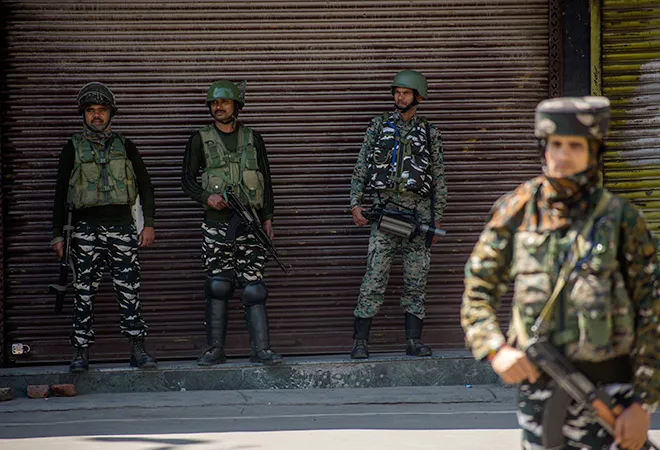
Ever since the decision to alter the constitutional status and relationship of the erstwhile state of Jammu and Kashmir, the government of India’s narrative that everything is hunky-dory in Kashmir has been questioned and ripped into smithereens by the international media. The news coverage of the foreign press has created a perception that large scale protests are taking place in the Kashmir Valley and the government appears desperate to shut down this message. While the narrative of the foreign media may or may not be convincing for the uninitiated members of the audience or for the casual observers of the Kashmir conflict, it is important to understand how government’s own handling of the situation and the narrative associated with it has provoked a storm of negative press.
There can be no denying that the clampdown in the Valley is unprecedented. But is it also true that the levels of violence are very low by the standards of the past? The reason is that the security managers of the government seem to have factored in and controlled all variables that could trigger or provoke protests. To avoid a situation where thousands of protestors descend on to streets and/or indulged in street violence, absolute restrictions on communication have been imposed. But it is not possible to impose absolute restrictions on the movement of citizens because of medical or other emergencies and because people need access to day to day necessities. Consequently, the government had to allow some degree of civilian movement.
There can be no denying that the clampdown in the Valley is unprecedented. But is it also true that the levels of violence are very low by the standards of the past?
The need for such a strict clampdown was undoubtedly based on the assessments of various security agencies operating in the region. The nature of clampdown is in itself indicative of the fact that the government apprehended a fierce public reaction to its decision. But this is the point where disconnect between the media strategy of the government and its stringent security measures on the ground become visible. If anything, the media managers of the government should have been quite alright with images of sporadic protests which belied the doomsday predictions of many analysts. Why then was the government so touchy and agitated about news stories that have shown a demonstration with a few thousand protestors or images from stone-pelting by a few dozen individuals?
Perhaps the mishandling of the narrative is because the government seems to have internalised its own propaganda. There is a dissonance between the security preparedness of the government and the political rhetoric wrapped around its decision. It is preposterous for anyone to have expected celebrations in Kashmir when the government had placed 7 million people of the Valley under a clampdown. Equally, ridiculous are the claims of government and particularly a section of the media to have suggested that things are and will remain calm in the Valley. Not surprising the government story crashed like a pack of cards.
For a section of domestic media and the international press, it wasn’t too difficult to negate the narrative put out by the government. Even one demonstration was sufficient to break the myth of ‘all is normal’ even as the government remained adamant in its denial. The government in its plans ahead of the decision to revoke Article 370 might not have anticipated the manner in which reporters managed to file their dispatches, flying to and fro from the Valley and sending pen drives out of the region on flights via messengers.
There is a dissonance between the security preparedness of the government and the political rhetoric wrapped around its decision. It is preposterous for anyone to have expected celebrations in Kashmir when the government had placed 7 million people of the Valley under a clampdown.
Compare the images of protests from the unrest of 2008, 2010 and 2016 with the ones that came out after the 5 August decision. In past scenes of mobs attacking security bunkers and razing them to the ground; ammunition dumps and even police stations being set on fire or for that matter stone pelters thrashing the hard iron of security vehicles with stones, rods and logs of wood, were plastered across both the print and electronic media. Compared to animated rage and proactive anger of the past, the current protests don’t appear to be anywhere close in magnitude.
A big reason for this is the presence of a large number of troops on the ground, which blocked all chokepoints and managed to restrict people in their homes. However, the current ‘calm’ should not delude the administration. The Valley will erupt; there should be no doubt about that. And that eruption will be both unpredictable as well as far more intense than previous situations.
Although the government’s clampdown has managed to cull the possibility of violence in the short run, it has already placed Kashmir across international headlines despite very little agitation or outpouring from the public. The domestic audience may be convinced and even celebratory about the restrictions, but the international community is not comfortable with it. One such indication comes from French President Emmanuel Macron’s statement that “France will be attentive to civilian rights in Kashmir.”
Hence, the question: what has the media blitzkrieg of the last few days and government’s tall claims achieved? A jubilant domestic audience has taken vicarious pleasure in the “meltdown” of Pakistan despite the fact that there are negative signals coming from other quarters. But, this domestic constituency was never a cause of worry for the government and has no direct stake in how the situation pans out over the next few months and years.
What has the media blitzkrieg of the last few days and government’s tall claims achieved?
Counter-intuitively, instead of creating a positive narrative, the way the public discourse has been mishandled and a false image projected by the media of ‘all is well’, has provoked more outrage and anger. Not surprisingly, reporters and their cameras are now at the receiving end of the public ire, as ground reports suggest. The whitewashing of the anger of people has actually provoked the population that has been struggling for days to make ends meets amidst restrictions, and waited for days to make one phone call to a loved one. Parents have refused to send their kids to schools, knowing well the government will sell such attendance as a symbol of normalcy. Even in the areas where restrictions have been lifted, people have decided to limit their movement to bare minimum to show normalcy and calm on the ground is distant.
Protests are however not new to Kashmir. The anger ebbs and flows. Today, there is barely any Kashmiri voice of dissent on TV screens and in newsprint. Any dissent or outpour of anger is either shut down, belittled or discredited. It is important for a democracy to decide whether it wants to channelise peoples’ anger through meek political activism or allow a few angry voices on television screens. Putting a fine gloss on a seething public and waiting for it to erupt in unexpected and unpredicted ways is hardly a sensible way to handle things in a place as sensitive, volatile and troubled as Jammu and Kashmir. Unless the government is deluded by its own rhetoric: that the Kashmir problem has been erased with a mere stroke of the pen.
The views expressed above belong to the author(s). ORF research and analyses now available on Telegram! Click here to access our curated content — blogs, longforms and interviews.




 PREV
PREV


